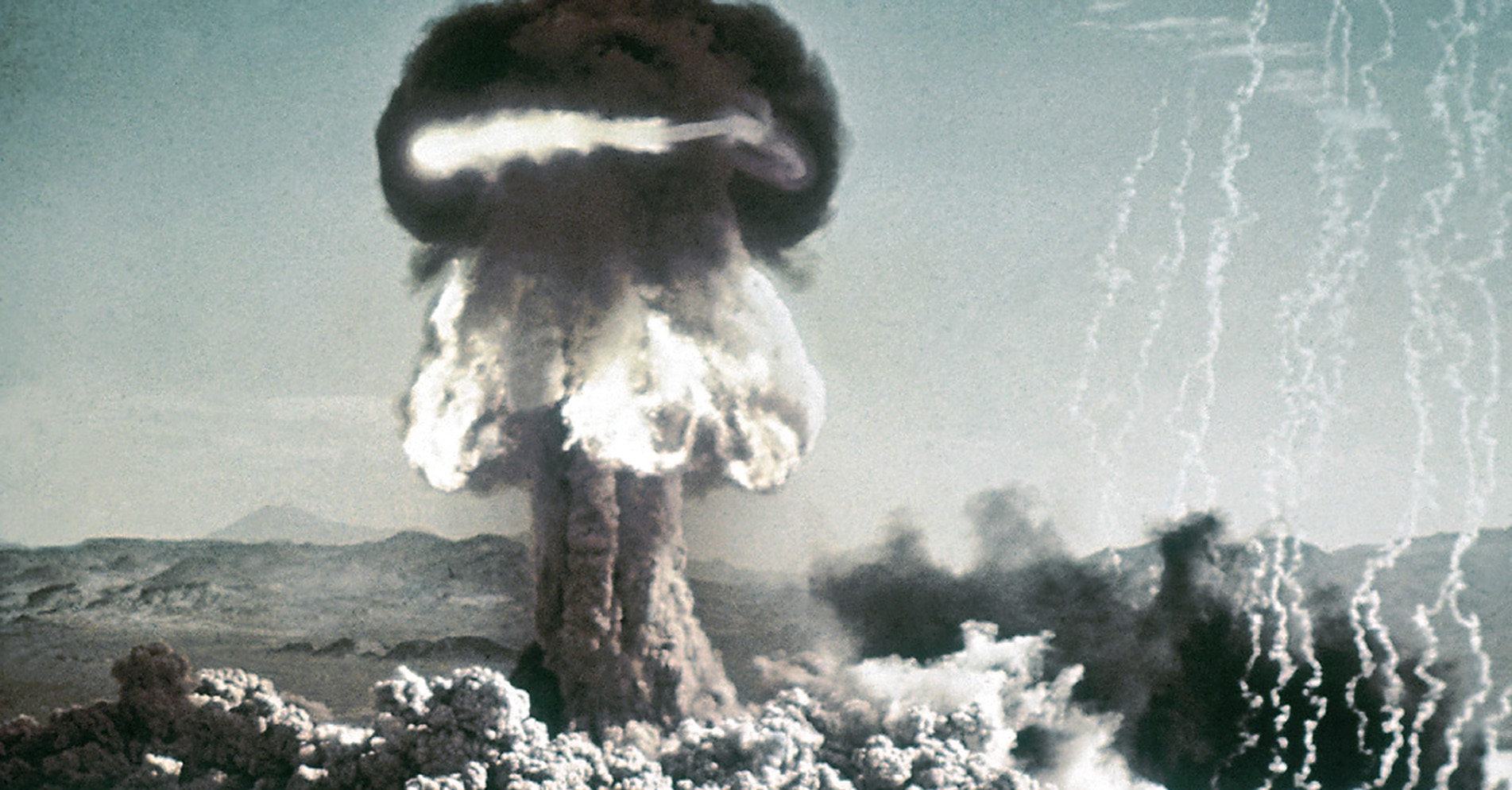MAVERICK CITIZEN
What do the Manhattan Project, your frying pan, and the Hartbeespoort Dam have in common? The answer is PFAS (Part One)

Polyfluoroalkyl, also known as forever chemicals, contamination is global, and they’re getting all the way to our water, right here in South Africa.
1.
This tale begins in the 1930s in the United States of America, and it starts with Roy J Plunkett.
Plunkett was born during the Great Depression and, in 1936, after receiving his doctorate in chemistry, he went to work for the EI DuPont de Nemours and Company (commonly known at that time as DuPont, and now known as DowDuPont).
Just two years after starting at DuPont, in April of 1938, Dr Plunkett made an accidental discovery while working with gases related to refrigerants. A frozen and compressed sample of tetrafluoroethylene had polymerised (combined) spontaneously into a white waxy solid — polytetrafluoroethylene (PTFE).
PTFE is a polymer — that is, a long chainlike molecule — and it is made up of carbon and fluorine atoms. Fluorine bonds so strongly with the carbon that other atoms cannot break in, so they simply slide across the surface.
Plunkett and his team discovered that PTFE was “the most slippery material in existence” and would not dissolve in acetone, ether, or concentrated sulfuric acid. It could withstand extreme temperatures — cold up to -240°C and heat up to 260°C. In fact, it was virtually indestructible.
Exactly the type of discovery you need just before a World War, especially when you’re trying to create an atomic bomb.
Soon, the existence of PTFE was made known to US Army General Leslie Groves, the director of the Manhattan Project. Groves commissioned DuPont to design a plant that would use PTFE on the seals and gaskets of pipes, to see if it would finally stop the powerful weapons-grade uranium (uranium hexafluoride) from corroding everything it came into contact with and producing dangerous health risks for those exposed. PTFE was just the chemical they were looking for. A forever chemical.
But, wars end and the need for PTFE on that weapons-grade uranium slowly dwindled. Capitalist greed, however, like PTFE, is everlasting.

The existence of PTFE was made known to US Army General Leslie Groves, the director of the Manhattan Project. Groves commissioned DuPont to design a plant that would use PTFE on the seals and gaskets of pipes, to see if it would finally stop the powerful weapons-grade uranium (uranium hexafluoride) from corroding everything it came into contact with. (Photo: history.com / Wikipedia)
2.
Much earlier in history, on the cusp of a different war — the South African War — another man was having ideas. General Hendrik J Schoeman, who at the time was living on his farm, Hartbeespoort, decided to build a concrete dam and name it after his wife, Sophia. At the opening of the Sophia Dam on 28 May 1898, Schoeman made a pledge to then president Paul Kruger to build a dam using government funds. The dam would irrigate the land in the area, and poor whites could settle there. He offered to sell a portion of his farm for the purposes.
But Schoeman had to wait almost 30 years and go through two wars (the South African and World War 1) before his dream would be a reality. Finally, in 1925, the arch dam was completed. At the west end of the dam, an arch built as a replica of the Arc de Triomphe read in Latin “without water it is arid and miserable in agriculture”.
Now, more than a century after Schoeman had great dreams, the dam built for irrigation also serves as a resort for holidaymakers and weekend break takers. Hartbeespoort Dam is the second most visited place in South Africa, after the V&A Waterfront in Cape Town, offering water sports, a yacht club, a bird sanctuary, restaurants, hikes, and crafts.
The dam is fed mainly by the Crocodile River but also by the Magalies. It supplies water through a more than 500km-long network of canals to more than 160km2 of farms where wheat, lucerne, fruit, tobacco and flowers are produced.
It has also, unfortunately, become one of “the worst examples of eutrophication” in the country. Pollution from industrial and domestic effluent in Gauteng have made the dam a source of very poor quality water. A continuous inflow of excess phosphate from sewage and via sediment has promoted algae growth and water hyacinth and according to a 2019 report:
“Mismanagement of waste water treatment works [WWTWs] within the catchment area are largely to blame … point source pollution in the form of malfunctioning WWTWs and diffuse sources from informal settlements present along streams and rivers within the catchment area, are responsible for the high nutrient levels. Many of these settlements use water directly from the river/stream.”
The Madibeng Municipality faced criminal charges in 2012 for pumping unpurified sewage into the Crocodile River, and the water in the municipality in general was found not to meet the quality standards for drinking water in 2020. The government has tried to fix this condition with little success, launching the Harties Metsi A Me (Harties, my water) programme and spending an estimated R900-million on this project and related community projects between 2004 and 2015.
But it’s not just the phosphates and the sewerage that we should be worried about.
In January this year, a study in the journal Water SA found high concentrations of per- and polyfluoroalkyl substances (PFAS) in the Hartbeespoort and Roodeplaat dams. These included PFOA (perfluorooctanoic acid) and PFOS (perfluorooctane sulfonic acid). The study found that:
“The measured concentrations of PFOS raise concerns of human exposure to these chemicals since they are above the US EPA advisory limit. This suggests that communities living within the vicinity of the dams are most likely exposed to these chemicals.”
3.
After World War 2 had ended, the DuPont company wanted to keep making money from PTFE and so it turned its mind to how it could be used in everyday life. But DuPont wasn’t the only company thinking about how to use fluorocarbon synthetic polymers. 3M, famous for Scotchgard and Post-it notes, was making its own version of the product to stop water and liquids from getting into fabrics. Other companies were working on combinations of long chain fluorocarbons too.
The team at DuPont realised that the same non-stick qualities that had been useful in bomb-building might be useful in the kitchen. In 1945, DuPont launched a household product under the name Teflon and began selling it commercially in 1946. By 1948, Du Pont’s first commercial plant, Washington Works in West Virginia, was manufacturing two million pounds (more than 900 tons) of Teflon a year.
DuPont began using Teflon coating on pans to prevent food from sticking, and other companies followed suit over the years, using Teflon and other PFAS on a range of products that reads like the credits in a high-budget film. They include food packaging, clothing to prevent water resistance (GoreTex was a spinoff created by a former DuPont employee using PTFE), water-resistant furniture, self-cleaning ovens, fire-fighting foams, mechanical heart valves, pacemakers, microwave popcorn bags, bicycle lubricants, ski wax, communication cables, pizza boxes, aeroplanes, car parts, artificial corneas, substitute bones for joints, nail polish, and artificial bile ducts.
A key ingredient in the Teflon mix was C8 — a chain of eight carbons and a fluorine — a chemical also known as perfluorooctanoic acid (PFOA). 3M sold PFOA to DuPont to manufacture Teflon — the vital ingredient that made their product so non-stick.
By 1961, Teflon and related products were earning the DuPont company a billion dollars a year.
4.
PFOA is just one of some 5,000 PFASs (sometimes also called perfluorinated organic compounds or PFCs) that have been synthetically created to date, and it is part of a bigger family of over 9,000 highly persistent chemicals that do not occur in nature and do not biodegrade.
Read here, here, here, here, here, here and here.
PFOA and PFOS (perfluorooctane sulfonic acid) have been the most widely produced and studied, and PFOS is, “volume-wise, one of the most produced PFASs”.
According to the United States Environmental Protection Agency (EPA), people can be exposed to PFASs found in:
- Food that is packaged in PFAS-containing material, processed with equipment that uses PFAS, or grown in PFAS-contaminated soil or water;
- Commercial household products, including stain- and water-repellent fabrics, non-stick products (eg Teflon), polishes, waxes, paints, cleaning products, and fire-fighting foams;
- The workplace, including production facilities or industries that use PFAS (chrome plating, electronics manufacturing, or oil recovery);
- Drinking water, typically localised and associated with a specific facility (e.g. manufacturer, landfill, wastewater treatment plant, firefighter training facilities); and
- Living organisms, including fish, animals and humans.
These “forever chemicals” bioaccumulate. That means, they gradually accumulate in our cells, being absorbed at a faster rate than we can eliminate them, building up over time.
According to the EPA, “there is evidence that exposure to PFAS can lead to adverse health outcomes in humans. The most-studied PFAS chemicals are PFOA and PFOS. Studies indicate that PFOA and PFOS can cause reproductive and developmental problems, liver and kidney cancers, and immunological effects in laboratory animals. Both chemicals have caused tumours in animals. The most consistent findings are increased cholesterol levels among exposed populations, with more limited findings related to low infant birth weight; effects on the immune system, cancer [for PFOA], and thyroid hormone disruptions [for PFOS].”
Other studies show that PFAS have been associated with decreased fertility, thyroid diseases, hypertension, and preeclampsia in humans, and prenatal exposure to PFAS has been linked to low birth weight, lower growth outcomes, decreased antibody response to childhood vaccines, a higher prevalence of cardiovascular diseases, hypertension and respiratory problems.
The EPA goes on to state that “drinking water can be a source of exposure in communities where these chemicals have contaminated water supplies. Such contamination is typically localised and associated with a specific facility, for example an industrial facility where PFAS were produced or used to manufacture other products, or an oil refinery, airfield, or other location at which PFAS were used for firefighting.”
In short, PFAS are harmful. Very harmful.
But companies keep making them.
5.
PFOA and PFOS are essential to the manufacture of Teflon and when it is produced the chemicals are released into the air in dust particles. DuPont also pumped the sludge by-product of its mass manufacturing into rivers in West Virginia and dug mass ditches where the sludge was buried. The leachate from these ditches ended up in the groundwater.
The US Federal Toxic Substances Control Act requires companies that work with chemicals to report to the EPA any evidence they find that shows or suggests that chemicals are harmful. It relies on the companies to come forward voluntarily.
Yet, within the first few years that DuPont started making Teflon in high quantities, the workers at its plants started getting sick, experiencing nausea and fever. All through the ’60s, ’70s, and ’80s, DuPont and 3M were conducting studies on the risks associated with manufacturing these products. Though the signs were bad, they continued to make PFAS-containing products.
In 1961, an internal memo from a DuPont toxicologist warned that PFAS chemicals enlarged rat and rabbit livers. In 1962, Du Pont thought it would test just how bad Teflon was by giving their workers cigarettes laced with it. Every worker who smoked one was hospitalised with “polymer fume fever”, obstruction of the airways, and flu-like symptoms. In 1965 DuPont conducted a rat study that showed increased liver and kidney weight and increased spleen size when exposed to PFOA. In 1970, DuPont scientists in an internal memo said that PFAS is highly toxic when inhaled. In 1973, DuPont’s own study showed that exposure to PFAS in food packaging causes liver damage. So, in 1975 it warned 3M about the toxic effects of PFAS in food packaging.
But by that time, 3M, which was supplying the PFOA to DuPont, already knew it was dangerous. In 1950, its study on mice revealed that PFAS builds up in the blood. In 1963, a technical manual from its plant deemed PFAS toxic. In 1966 its study on rats found that PFAS caused acute oral toxicity, and in 1970 it warned the magazine of the National Fire Protection Association that PFAS was toxic to fish. In 1975 it was informed that PFAS builds up in human blood samples. In 1977 it began testing its workers and other animals to measure PFAS in blood and found that PFOS (the PFA found in Scotchgard) was “more toxic than anticipated”. Their 1978 study results found that exposure to PFAS led to lesions on animal spleens, lymph nodes, and bone marrow and concluded in an internal document that PFOS and PFOA, used to make DuPont’s Teflon, “should be regarded as toxic”.
In 1979, 3M also conducted a study that exposed rhesus monkeys to PFOA. Those given the highest doses all died within five weeks, and all monkeys became ill within the first week of exposure. In 1979, DuPont surveyed its employees at the West Virginia Teflon plant and found possible evidence of liver damage and in 1981 3M and DuPont reassigned all female workers of PFAS production lines after animal studies revealed that PFAS damages the eyes of the developing foetus.
It was a move that came too late. Women on the DuPont Teflon line gave birth to babies with facial deformities. When they demanded answers from DuPont and asked whether it had been their exposure to Teflon that caused it, the company denied that it had anything to do with it.
The studies continued, but the companies said nothing. In 1983 a 3M study showed the potential harm to the immune system caused by PFAS exposure, and in 1984 3M documented rising fluorine levels in workers’ blood. In 1984 DuPont detected that there was PFAS in the tap water in a town in Ohio, but didn’t let the local water authority know. 3M studies found in 1987 that PFOA was linked to tumours in animals, in 1989 that PFAS workers had elevated cancer rates, and in 1990 that exposure to PFOA increased the risk of testicular cancer, and in 1992 that PFOA workers were more likely to die from prostate cancer. DuPont’s studies had similar results. In 1992 and 1997, it found that its workers had elevated cancer rates. In 1995, a DuPont scientist expressed concern over long-term PFAS health effects.
In 1998, 3M found that PFAS moves through the food chain. Animals that eat other animals exposed to PFAS have higher concentrations of PFAS. Finally, in 1998, 3M provided the EPA with evidence of PFAS accumulation in the blood. This led to the withdrawal of the Scotchgard chemical from the market.
In 1999, a farmer from West Virginia arrived at the offices of Rob Bilott, a lawyer for the Taft law firm. For the past 20 years, class action lawsuits like those led by Bilott have tried to hold companies like DuPont accountable for the harm they have caused to their workers, and the broader public with the manufacture of forever chemicals. But the battle is still ongoing.
And they are still making these known to be dangerous chemicals, and some new ones, every single day.
Contamination is global, and it’s getting all the way to our water, right here in South Africa. DM/MC/OBP




















 Become an Insider
Become an Insider
Great, very well written piece that highlights an often neglected form of environmental destruction and makes for chilling reading.
Industry owes the people of the world plenty, and not just tax payments.
Dark Waters is an excellent documentary about this